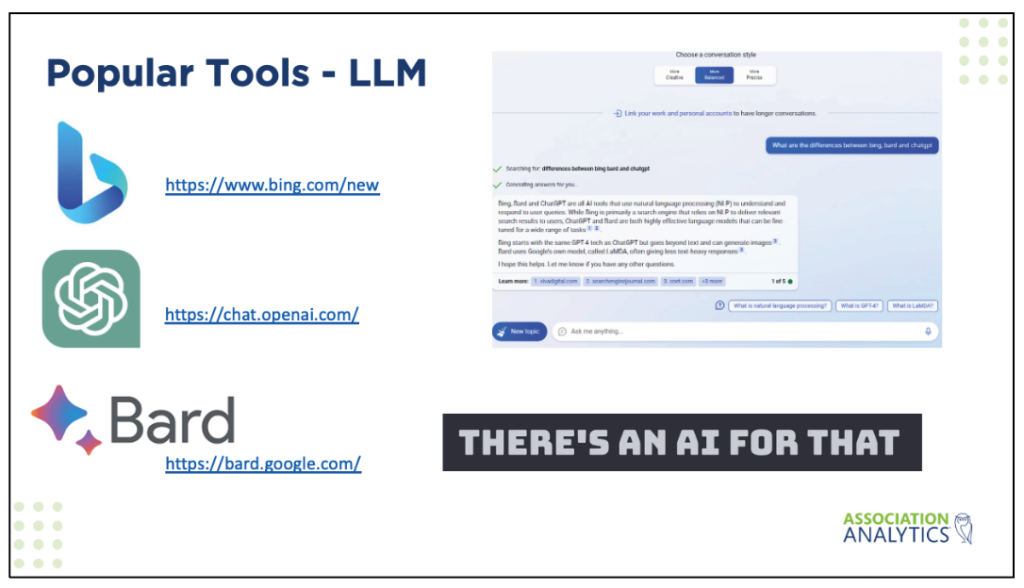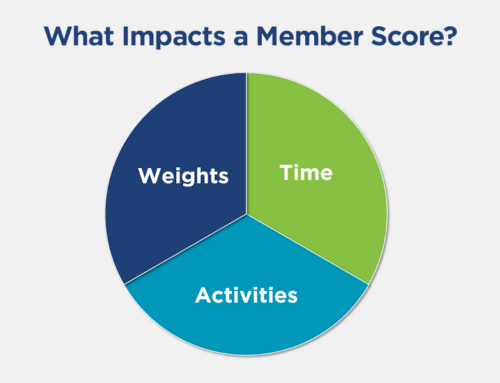AI has garnered a lot of global and national attention across most industries in recent months. Popular AI tools like ChatGPT and Bard are continuously learning how to work faster and more efficiently, which can stir up a lot of feelings in us humans. As such, some organizations have already jumped on the bandwagon and are quickly adapting, while others are hesitating to embrace the potential of this technology. With no real sign of AI slowing down or fading away, it’s worth taking the time now to prepare your association for the impact and influence AI will have on your members and employees.
Types of AI Tools
To start, it’s important to know about some of the models already available to the public. The most popular model today is called a Large Language Model (LLM), which is trained on massive text datasets. LLMs are meant to produce conversational human language responses.
 While ChatGPT is likely the LLM name you’ve heard about the most, it’s not the only one available. With the amount of data available, tools are leapfrogging each other monthly, which means it might take some research to find which one works best for you. The key to determining which tools to work with depends on your goals. Keep in mind that the more specific the model gets and the more specific the training dataset, the better outcomes you’ll find.
While ChatGPT is likely the LLM name you’ve heard about the most, it’s not the only one available. With the amount of data available, tools are leapfrogging each other monthly, which means it might take some research to find which one works best for you. The key to determining which tools to work with depends on your goals. Keep in mind that the more specific the model gets and the more specific the training dataset, the better outcomes you’ll find.
It’s also crucial to remember that by using a public AI tool, your organization’s data can become part of the training dataset. By providing data, you’re helping these tools learn and become more efficient, but now “your” data has become “their” data too. That’s why it’s important to have internal conversations about how much data your organization feels comfortable sharing and what data is proprietary and should not be used with public AI tools.
AI’s Impact on Staff and Members
Let’s say your team is on board with using AI, but you have no idea where to start. A simple first step would be to complete a time study of all your tasks to determine what you might want to automate. For example, if you’re a marketing specialist, you might ask the tool to help compose tweets for podcast promotions or come up with a few subject lines for your emails. Today’s lightweight apps will provide your staff with an opportunity to get to know how these tools function and save some time along the way – and that’s ultimately the first step to embracing AI.
It’s equally important to think about how AI will impact your members. Much like how robotics impacted blue collar jobs in the 1980s, AI is predicted to be a massive disrupter for white collar jobs. If your association caters to healthcare, law, finance, or other industries, start brainstorming about how your members can use AI to create content and make better decisions faster. This will position you as a thought leader for the industry and help your members in the long run.
One great example of association’s rising to the occasion as thought leaders for their members is the COVID response. Within just a few months, most associations had publicly posted recommendations and tips, provided amnesty for dues, created policies and procedures, and/or jumped to virtual tools to continue providing events. Research how AI might impact your members’ careers and what steps they can take to protect that from happening. For instance, your association might consider creating advocacy campaigns and scheduling lobby days. Additionally, you might consider what new products or services you could provide that might also increase your non-dues revenue with the help of AI. There’s a lot of opportunity to step up as an association when it comes to being there for your members!
Evolving Your Relationship with AI Using Prompt Engineering
As you get more familiar with how the tools work, you’ll want to dive deeper into prompt engineering. Prompt engineering is the process of crafting specific prompts – including data input, queries, and/or searches – and entering them into the AI tool to get an answer. The difference is in the details and playing around with what you enter, much like an Internet search. Ideally, you’ll want to keep track of the output you’re getting so that you can continue to improve your prompt engineering strategy and future prompts. The more detailed data you give the AI, the better answers you’re going to get back.
For example, you could use an AI tool to help determine the best location for your annual orthodontist convention. As a first prompt, you might ask it to provide three cities based on where your association held its conference over the last five years. The results?
- San Diego, California
- Orlando, Florida
- Seattle, Washington
Let’s say these all sound appealing, but you want to get a bit more granular. For the second prompt, you include what you had in the first prompt and then add that you’re also looking for a conference center that can hold 3,5000 attendees, vendors, and staff, and is located within walking distance of hotels and eateries. The answers might shift a little bit with this input:
- San Diego, California
- Orlando, Florida
- Las Vegas, Nevada
You can dig into your data to find out more specifics. If you see your members are typically more available in the late spring, you can provide a third prompt, adding that the city shouldn’t get any hotter than 80 degrees in mid-May. With this additional information, you might start to get back significantly different answers like:
- Portland, Oregon
- Seattle, Washington
- Asheville, North Carolina
If you’d like to explore other ways to use prompt engineering for your convention, you could also ask for sessions and track suggestions, marketing campaigns for your attendee personas, or email copy for each of your campaigns. The more you put into prompt engineering, the better results you get, and the more likely you are to look like a rockstar when approaching your manager or leadership with your final recommendations. And, as we explain in the next section, having all your association’s data organized and centralized will make great prompts much easier and more successful.
Preparing Your Data for the Future of AI
Your data is your association’s asset. Take time to consider what your highest value data is, ways to consistently collect it, and then store it all in one place. With a centralized location, you’ll be able to access past behaviors and demographics of your members quickly and efficiently, which will come in handy as you embrace and improve your prompt engineering skills. As previously mentioned, the more detailed information you put into the system, the better results you’ll get. Additionally, storing your data in one place is key to having the right analytics data and training datasets for AI – particularly for private models which is one of the most exciting possibilities for associations.
Imagine a world where your members login to your member portal and a ChatBot appears. That ChatBot holds all your association’s data so it can answer any question they have about their membership; benefits you offer members or upcoming events. It can even answer questions they have about issues impacting their industry and the resources your association offers to help them. Now imagine another world, where the ChatBot lives on your public website and shares similar information with potential new members – showing them the value they get from becoming a member.
We believe this will be the wave of the future for associations. While we’re not quite there yet, you can prepare now by organizing and centralizing your data, so you have a smooth transition to using a private, more specialized AI model when the time comes.
Prepare and Embrace
Whether or not you’re super excited or a tad bit scared, AI is here to stay. Much like the Internet in the 90s, AI will change the way the world works so instead of running for the hills, let’s make sure we’re prepared and ready to embrace it! The more effort you put into familiarizing your association with the tools and technology, the better off you’ll be in the future. Instead of playing catch up, you’ll be ready to fully leverage AI for yourself, your association, and your members.
Association Analytics’ platform, Acumen, is one way for you to easily bring all your data together in one place so you’re ready to leverage AI. In fact, we’ve been using AI for years to predict member renewals and event attendees. Acumen’s recommendations engine predicts and recommends relevant content, products, and services. We’ve also recently expanded Acumen’s AI features to surface insights right to your inbox, provide best practice recommendations on actions to take and give you language that you can use or edit to implement the recommendations.
To learn more about how you can start to use AI, schedule a quick call with one of our experts or book a demo of Acumen. You can also learn more by watching our on-demand webinar on this same topic.



